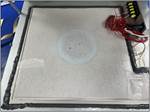Cannon introduces in-line resin degassing unit for infusion, RTM and pultrusion processes
Fully automatic system for processing large composite structural parts reduces overall degassing time in a single compact unit.
Cannon Legos (Peschiera Borromeo, Italy), a company of The Cannon Group, showcases an innovative, fully automatic system for the in-line vacuum degassing of resins for the production of large composite components using vacuum infusion, resin transfer molding (RTM) and pultrusion. The system combines a compact design and footprint, offering high output and a reduction in processing times.
“We started developing this technology based on the requirements for the wind energy market. As the sector moves to ever larger wind blades for bigger power generation, there is a strong demand for greater outputs without compromising performances and costs,” explains Davide Bertinat, product manager at Cannon Legos. “The technology we developed is building on the experience that Cannon has in the oil and gas sector, particularly for water treatment on offshore platforms. This was then adapted and customized for resin degassing and, after a period of testing and adjusting, we achieved the desired high in-line output, while maintaining a small footprint.”
At present, degassing technologies are mainly operated off-line in batches with low throughput and long processing times. Although some existing technologies are already aimed at in-line processes, these tend to have limited output. To bypass this, some suppliers will offer more than one unit to cover higher volumes.
The solution from Cannon Legos is said to significantly reduce the overall degassing time, processing 1 m3 intermediate bulk container (IBC) in less than 10 minutes. This solution enhances efficiency and ensures an optimized footprint, even at high output rates. Moreover, a single Cannon unit can replace several existing modules, enabling customers full integration in production processes thereby saving operating costs, time and space.
The company’s in-line degassing technology is not only well-suited to produce large wind turbine blades. It can also be used in other production processes where the presence of air or gas bubbles in chemicals needs to be minimized in order to improve the integrity of the final product, such as structural parts for the automotive industry, aerospace applications or battery trays.
Related Content
-
Low-cost, efficient CFRP anisogrid lattice structures
CIRA uses patented parallel winding, dry fiber, silicone tooling and resin infusion to cut labor for lightweight, heavily loaded space applications.
-
Mel Composites infusion strategy enables Sasga Yachts fiberglass hull designs
Mel’s ongoing partnership culminates in the development of the Menorquín 42 and Menorquín 54 motor yachts, as well as extension of Sasga’s capacity for 68-foot-length boats.
-
Melker of Sweden accomplishes sea kayak with 100% sustainable composite construction
Built with ampliTex flax fabrics, a solid cork core and Sicomin plant-based resins, the company’s Värmdö kayak model highlights an environmentally conscious design for paddlers of all levels.

















